1990 VOLKSWAGEN TRANSPORTER change time
[x] Cancel search: change timePage 3 of 165
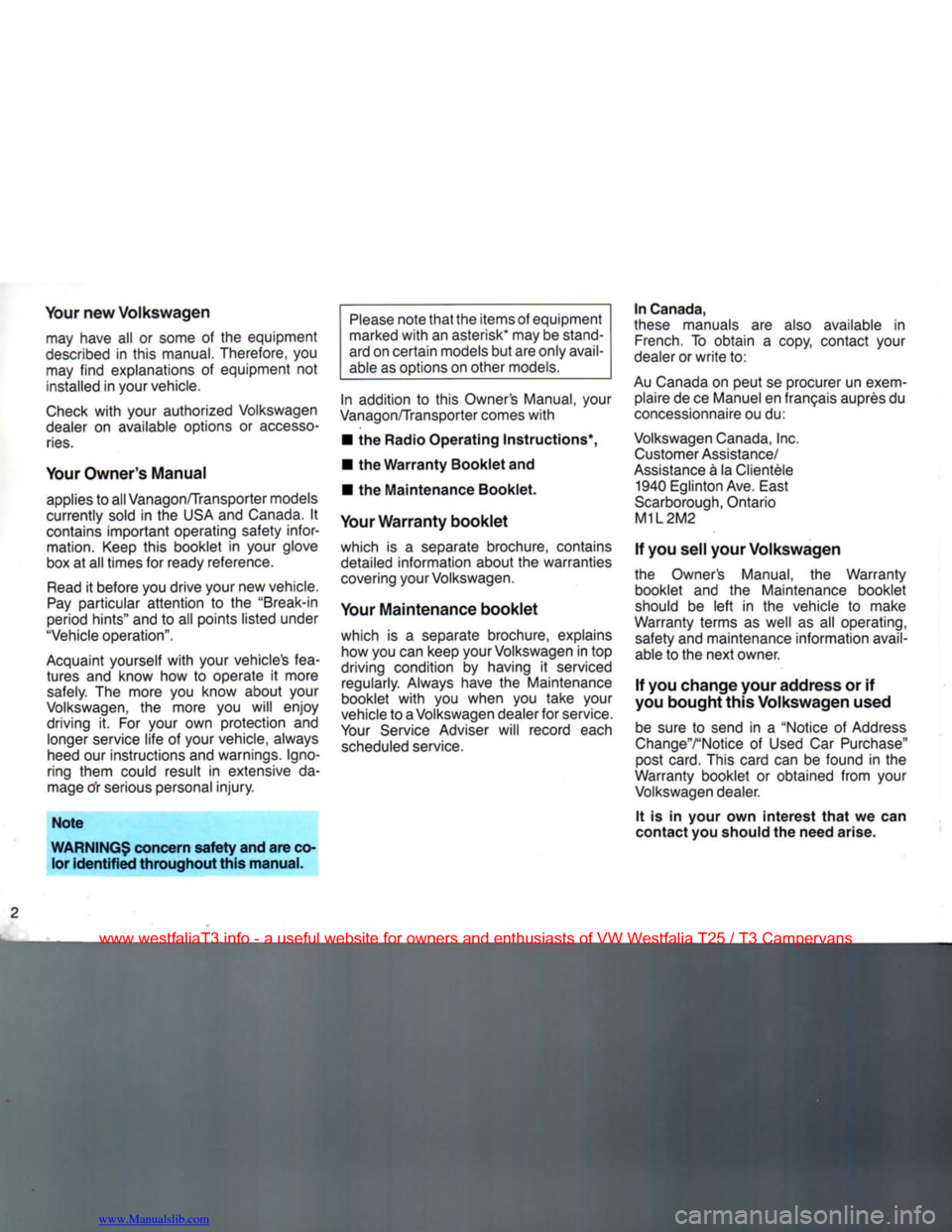
Downloaded from www.Manualslib.com manuals search engine
Your new
Volkswagen
may have all or some of the equipment
described
in this manual. Therefore, you may find explanations of equipment not
installed in your vehicle.
Check
with
your authorized Volkswagen
dealer
on available options or
accesso
ries.
Note
WARNINGS
concern
safety
and are co lor
identified
throughout
this
manual.
Please
note
that
the items of equipment
marked
with
an asterisk* may be stand
ard on certain models but are only avail
able
as options on other models.
In addition to this Owner's Manual, your
Vanagon/Transporter
comes
with
• the Radio
Operating
Instructions*,
In Canada,
these
manuals are also available in
French.
To obtain a copy, contact your
dealer
or
write
to:
Au
Canada
on peut se procurer un exem- plaire de ce Manuel en francais aupres du
concessionnaire
ou du:
Volkswagen
Canada,
Inc.
Customer
Assistance/
Assistance
a la Clientele 1940 Eglinton Ave. East
Scarborough,
Ontario
M1L2M2
If you sell your
Volkswagen
the Owner's Manual, the Warranty booklet and the Maintenance booklet
should
be
left
in the vehicle to make
Warranty terms as well as all operating, safety and maintenance information avail
able
to the next owner.
If you change your address or if
you
bought
this
Volkswagen
used
be
sure to send in a "Notice of Address
ChangeVNotice
of Used Car Purchase"
post card. This card can be found in the
Warranty booklet or obtained from your
Volkswagen
dealer.
It is in your own
interest
that
we can
contact
you should the
need
arise.
Your
Owner's
Manual
applies
to all Vanagon/Transporter models
currently sold in the USA and
Canada.
It
contains important operating safety infor mation. Keep this booklet in your glove
box at all times for ready reference.
Read
it before you drive your new vehicle.
Pay
particular attention to the "Break-in
period hints" and to all points listed under
"Vehicle
operation".
Acquaint
yourself
with
your vehicle's fea tures and know how to operate it more
safely.
The more you know about your
Volkswagen,
the more you will enjoy driving it. For your own protection and longer service life of your vehicle, always
heed
our instructions and warnings. Igno
ring them could result in extensive da
mage
or serious personal injury. • the
Warranty
Booklet
and
• the
Maintenance
Booklet.
Your
Warranty
booklet
which is a separate brochure, contains
detailed information about the warranties
covering your Volkswagen.
Your
Maintenance
booklet
which is a separate brochure, explains how you can keep your Volkswagen in top
driving condition by having it serviced regularly. Always have the Maintenance
booklet
with
you when you take your
vehicle
to a Volkswagen dealer for service.
Your
Service Adviser will record each
scheduled
service.
www.westfaliaT3.info - a useful website for owners and enthusiasts of VW Westfalia T25 / T3 Campervans
Page 49 of 165

Downloaded from www.Manualslib.com manuals search engine
fCONTROLS AND EQUIPMENT
TURN SIGNAL / HEADLIGHT DIMMER SWITCH LEVER
Turn signals
The turn signal indicator light flashes when you operate the lever (ignition on).
Lever up - right turn signal
Lever down - left turn signal
The turn signals are cancelled automatic ally when you have completed a turn (for
example when turning a corner), and the
steering wheel returns to the straight-
ahead position.
If a turn signal fails, the indicator light
flashes about twice as fast. A light bulb may have to be replaced. Headlight dimmer
With headlights on (light switch in second
stop),
you can switch to either high or low beam by pulling the lever toward the steering wheel past the point of resistance.
When high beam is on, the indicator light will light up.
Headlight flasher
With headlights on or off, you can signal with your headlights (in lieu of horn), by repeatedly pulling the lever just up to the
point of resistance.
Lane changer
Move the lever up or down just to the point
of resistance - the indicator light must also flash at the same time. The lever will
return to the OFF position when released.
The lever will return to the OFF position when released.
www.westfaliaT3.info - a useful website for owners and enthusiasts of VW Westfalia T25 / T3 Campervans
Page 61 of 165

Downloaded from www.Manualslib.com manuals search engine
I
CONTROLS AND EQUIPMENT
AUXILIARY HEATER* (Syncro models only)
The auxiliary heater* heats the coolant in the heating circuit and supplies the heat exchanger in the normal heating system
and the additional heat exchanger* for the
passenger compartment heating with heated coolant.
The system is switched off and on or the
switch-
on time preselected by means of a
switch and indicator unit located on the left under the instrument panel.
Air distribution and regulation is done with the controls of the normal heating and
ven
tilation system (see "Ventilation/Heating"
on page 51).
The auxiliary heater can be used with vehicle stationary or when it is moving.
When vehicle is stationary, the heater only runs for a maximum of 30 minutes in order
to avoid draining the battery. It also switches off automatically when a coolant
temperature of 80° C (175° F) is reached.
When the coolant temperature drops below 70° C (158° F) the heater is automatically switched on again. The heater runs on fuel from the vehicle
tank and uses up to half a litre (one quart) per hour. Controls
A - Buttons for setting time and
preselected time
B - Indicator lamp for preselected time
C - Preselected time D - Display
E - Actual time
F - Heater on/off
G - Warning lamp (Heater on)
60 "where applicable
www.westfaliaT3.info - a useful website for owners and enthusiasts of VW Westfalia T25 / T3 Campervans
Page 73 of 165
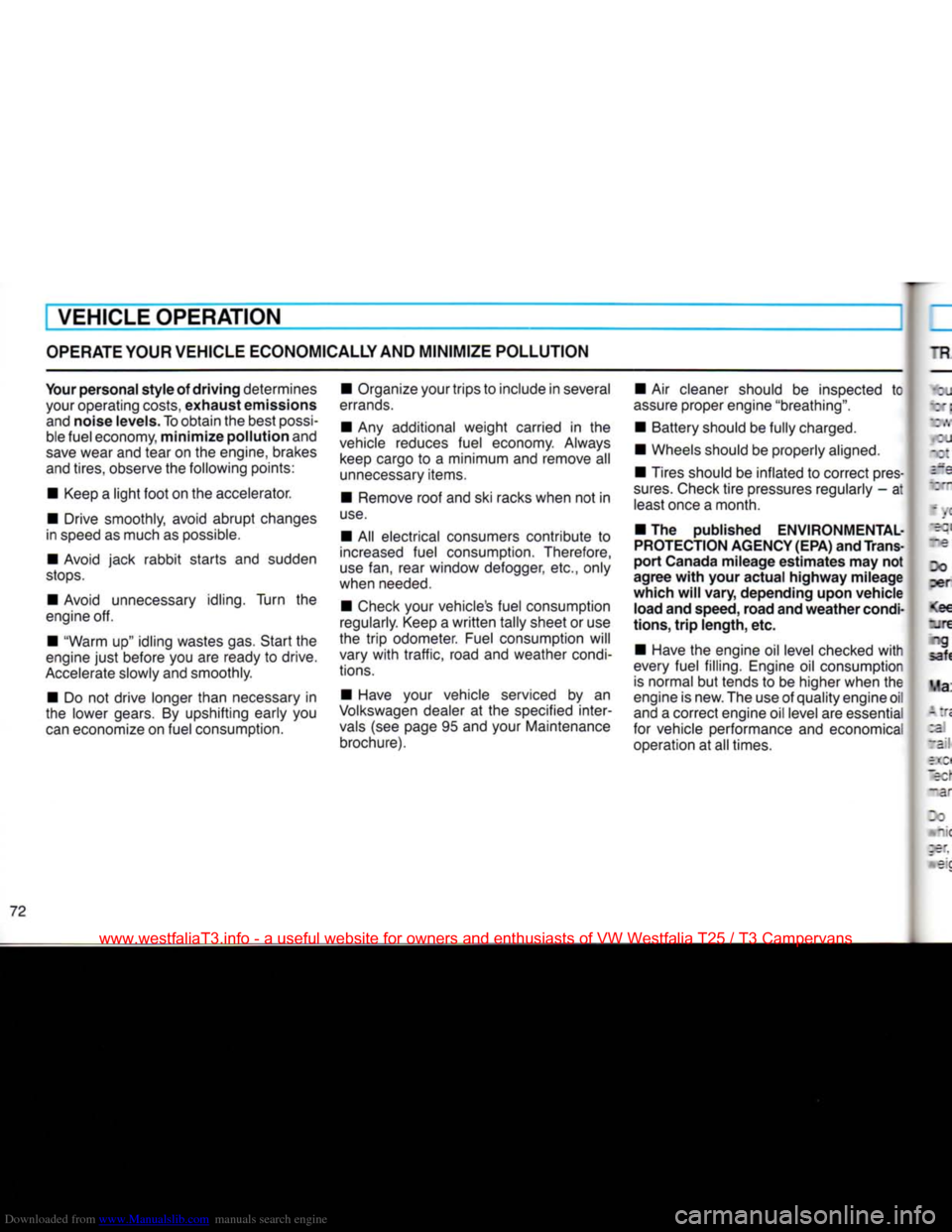
Downloaded from www.Manualslib.com manuals search engine
VEHICLE OPERATION
OPERATE
YOUR VEHICLE ECONOMICALLY AND
MINIMIZE
POLLUTION
Your
personal
style
of
driving
determines your operating costs,
exhaust
emissions and noise levels. To obtain the best
possi
ble fuel economy,
minimize
pollution
and
save
wear and tear on the engine, brakes
and tires, observe the following points:
• Keep a
light
foot
on the accelerator.
• Drive smoothly, avoid abrupt changes
in speed as much as possible.
• Avoid jack rabbit starts and sudden
stops.
• Avoid unnecessary idling. Turn the
engine off.
• "Warm up" idling wastes gas. Start the
engine
just
before you are ready to drive.
Accelerate
slowly and smoothly.
• Do not drive longer than necessary in
the lower gears. By upshifting early you
can
economize on fuel consumption. • Organize your trips to include in several
errands.
• Any additional weight carried in the
vehicle reduces fuel economy. Always keep cargo to a minimum and remove all
unnecessary
items.
• Remove roof and ski racks when not in
use.
• All electrical consumers contribute to
increased
fuel consumption. Therefore,
use
fan, rear window defogger, etc., only
when needed.
• Check your vehicle's fuel consumption
regularly. Keep a
written
tally sheet or use
the
trip
odometer. Fuel consumption will
vary
with
traffic, road and weather condi
tions.
• Have your vehicle serviced by an
Volkswagen
dealer at the specified inter
vals
(see page 95 and your Maintenance brochure). • Air cleaner should be inspected to
assure
proper engine "breathing".
• Battery should be fully charged.
• Wheels should be properly aligned.
• Tires should be inflated to correct pres
sures.
Check
tire
pressures regularly - at least once a month.
• The published ENVIRONMENTAL-
PROTECTION AGENCY (EPA) and Trans
port
Canada
mileage
estimates
may not
agree
with
your
actual
highway
mileage
which
will
vary,
depending
upon
vehicle
load
and speed,
road
and
weather
condi
tions,
trip
length,
etc.
• Have the engine oil level checked
with
every fuel filling. Engine oil consumption
is
normal but tends to be higher when the
engine is new. The use of quality engine oil
and a correct engine oil level are essential
for vehicle performance and economical operation at all times.
72
www.westfaliaT3.info - a useful website for owners and enthusiasts of VW Westfalia T25 / T3 Campervans
Page 80 of 165
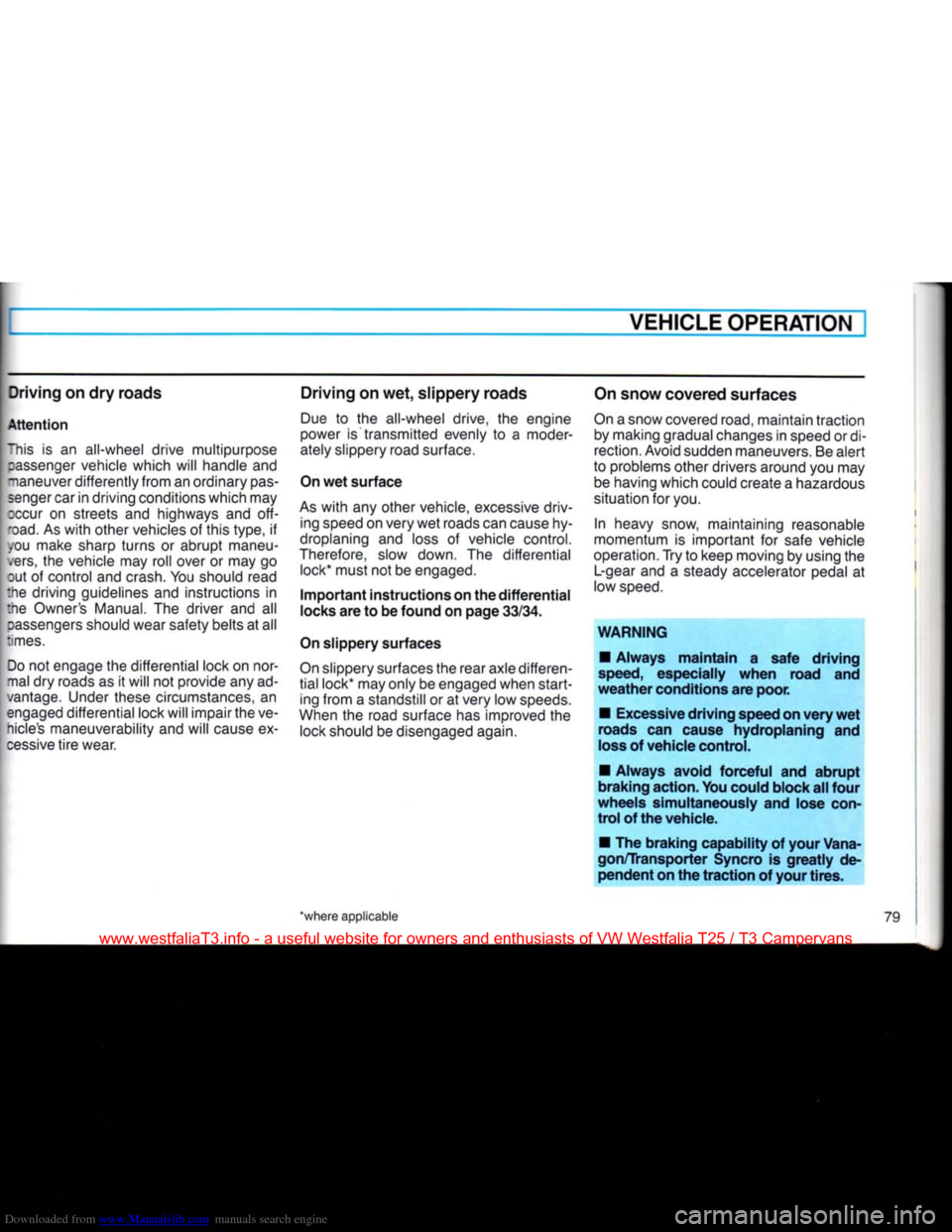
Downloaded from www.Manualslib.com manuals search engine
-
VEHICLE
OPERATION
Driving on dry roads
Attention
"his
is an
all-wheel drive multipurpose
rassenger
vehicle which
will
handle
and
maneuver
differently
from
an ordinary
pas
senger
car in driving conditions which may
occur
on
streets
and
highways
and off-
'oad.
As
with
other vehicles
of
this type,
if
you make sharp turns
or
abrupt maneu
vers,
the
vehicle
may
roll over
or
may
go
kit
of
control and
crash.
You should read
:he driving guidelines
and
instructions
in
the Owner's
Manual.
The
driver
and all
oassengers
should wear safety belts
at all
times.
Do
not
engage
the
differential lock on nor
mal
dry
roads
as it
will
not
provide any ad
vantage. Under these circumstances,
an
engaged differential lock
will
impair the ve-
nicle's
maneuverability and
will
cause
ex
cessive
tire
wear.
Driving on wet, slippery roads
Due
to the
all-wheel drive,
the
engine
power
is
transmitted evenly
to a
moder
ately slippery road surface.
On
wet surface
As
with
any
other vehicle, excessive driv ing speed on very wet roads can cause hy
droplaning
and
loss
of
vehicle control.
Therefore, slow down.
The
differential lock* must
not be
engaged.
Important
instructions
on
the
differential
locks
are to be found on page
33/34.
On
slippery surfaces
On
slippery surfaces the rear axle differen
tial
lock may only be engaged when
start
ing
from
a
standstill
or at
very low
speeds.
When
the
road surface has improved
the
lock should
be
disengaged again. On
snow covered surfaces
On
a
snow covered road, maintain traction by making gradual changes
in
speed
or
di
rection. Avoid sudden maneuvers. Be alert
to problems other drivers around you may be having which could create
a
hazardous
situation
for
you.
In heavy snow, maintaining reasonable
momentum
is
important
for
safe vehicle
operation. Try
to
keep moving
by
using
the
L-gear and
a
steady accelerator pedal
at
low
speed.
WARNING
•
Always
maintain
a safe driving
speed,
especially
when
road and
weather
conditions are poor.
•
Excessive
driving speed on very wet
roads can cause hydroplaning and
loss
of vehicle control.
•
Always avoid forceful and
abrupt
braking action.
You
could block all four
wheels simultaneously and lose
con
trol
of the vehicle.
•
The braking capability of your Vana-
gon/Transporter Syncro is
greatly
de
pendent on the
traction
of your tires.
'where applicable 79
www.westfaliaT3.info - a useful website for owners and enthusiasts of VW Westfalia T25 / T3 Campervans
Page 91 of 165
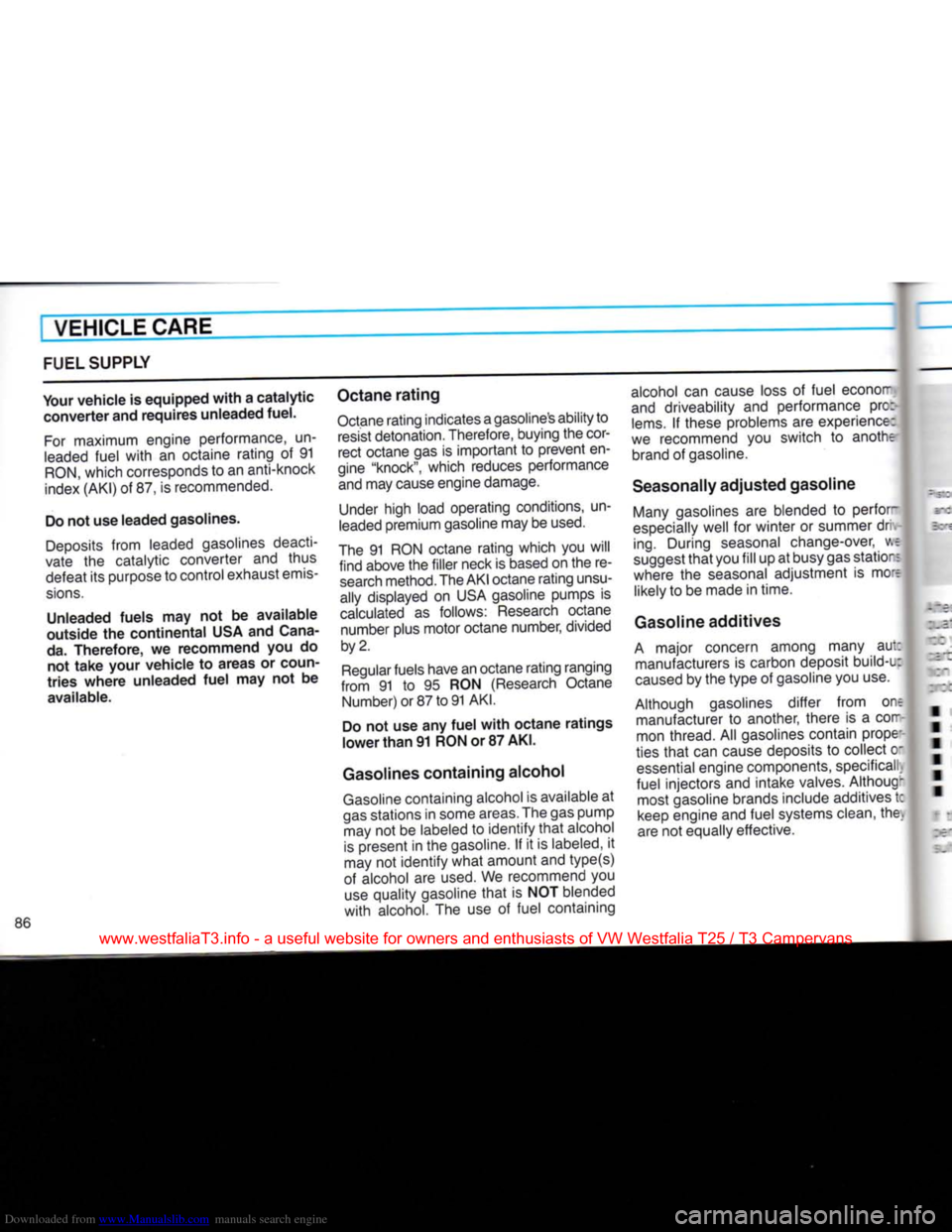
Downloaded from www.Manualslib.com manuals search engine
VEHICLE CARE
FUEL SUPPLY
Your vehicle is equipped with a catalytic converter and requires unleaded fuel.
For maximum engine performance, un
leaded fuel with an octaine rating of 91
RON,
which corresponds to an anti-knock
index (AKI) of 87, is recommended.
Do not use leaded gasolines.
Deposits from leaded gasolines deacti
vate the catalytic converter and thus
defeat its purpose to control exhaust emis
sions.
Unleaded fuels may not be available
outside the continental USA and Cana
da.
Therefore, we recommend you do not take your vehicle to areas or coun
tries where unleaded fuel may not be
available. Octane rating
Octane rating indicates a gasoline's ability to
resist detonation. Therefore, buying the cor
rect octane gas is important to prevent en
gine "knock", which reduces performance and may cause engine damage.
Under high load operating conditions, un
leaded premium gasoline may be used.
The 91 RON octane rating which you will find above the filler neck is based on the re search method. The AKI octane rating unsu-
ally displayed on USA gasoline pumps is
calculated as follows: Research octane number plus motor octane number, divided
by 2.
Regular fuels have an octane rating ranging
from 91 to 95 RON (Research Octane Number) or 87 to
91
AKI.
Do not use any fuel with octane ratings
lower than 91 RON or 87 AKI.
Gasolines containing alcohol
Gasoline containing alcohol is available at
gas stations in some areas. The gas pump may not be labeled to identify that alcohol
is present in the gasoline. If it is labeled, it
may not identify what amount and type(s)
of alcohol are used. We recommend you
use quality gasoline that is NOT blended
with alcohol. The use of fuel containing alcohol can cause loss of fuel econorr
and driveability and performance pre:
lems.
If these problems are experience:
we recommend you switch to anothe brand of gasoline.
Seasonally adjusted gasoline
Many gasolines are blended to perfor-
especially well for winter or summer drl
ing.
During seasonal change-over, wl
suggest that you fill up at busy gas statior I
where the seasonal adjustment is mo-r likely to be made in time.
Gasoline additives
A major concern among many aut: manufacturers is carbon deposit build-i:
caused by the type of gasoline you use.
Although gasolines differ from onr manufacturer to another, there is a cor-
mon thread. All gasolines contain props'
ties that can cause deposits to collect ad essential engine components, specificali
fuel injectors and intake valves. Althoug- most gasoline brands include additives tc
keep engine and fuel systems clean, the;,
are not equally effective.
www.westfaliaT3.info - a useful website for owners and enthusiasts of VW Westfalia T25 / T3 Campervans
Page 105 of 165
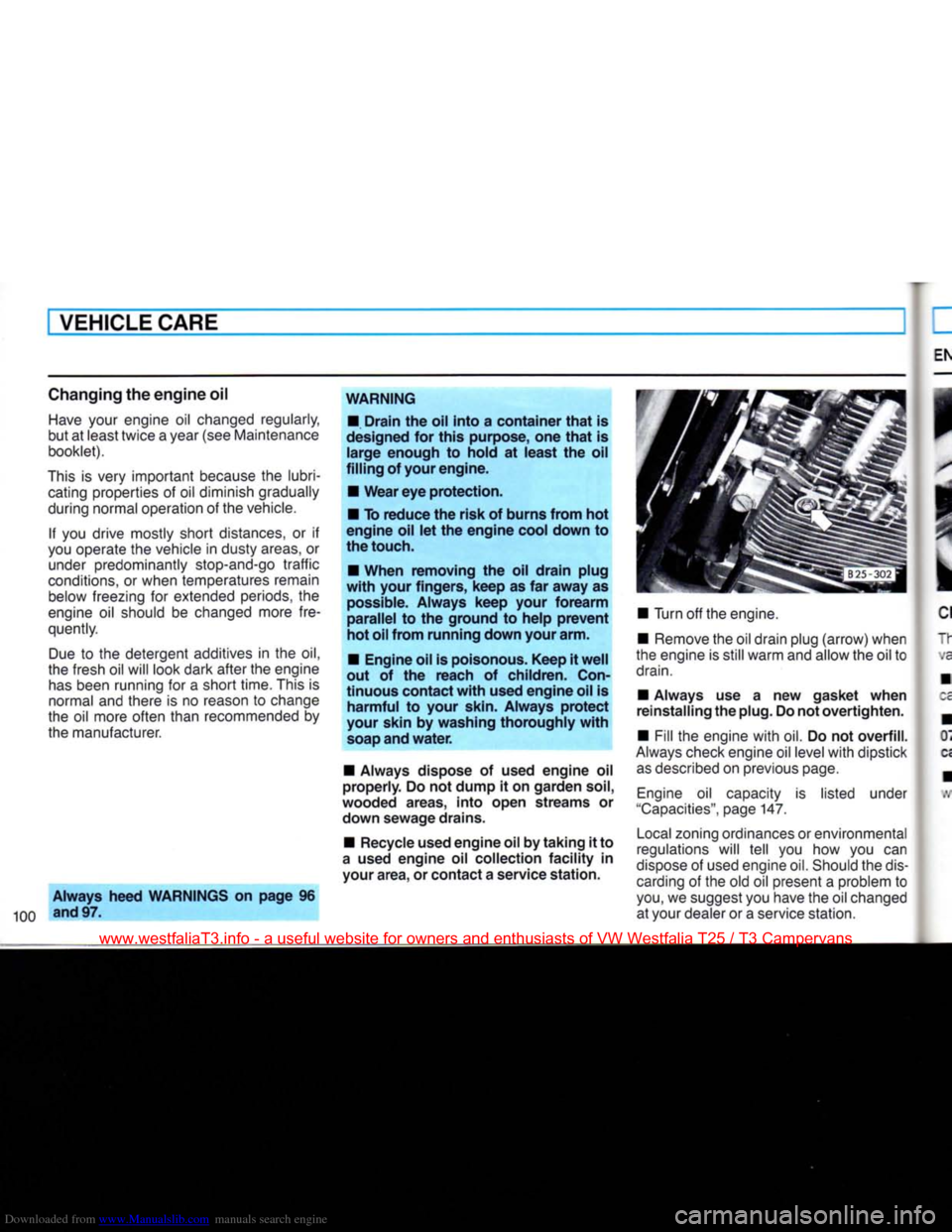
Downloaded from www.Manualslib.com manuals search engine
VEHICLE CARE
Changing the
engine
oil
Have
your engine oil changed regularly,
but at least twice a year (see Maintenance
booklet).
This
is very important because the lubri cating properties of oil diminish gradually
during normal operation of the vehicle.
If you drive mostly short distances, or if
you operate the vehicle in dusty
areas,
or under predominantly stop-and-go traffic
conditions, or when temperatures remain below freezing for extended periods, the
engine oil should be changed more fre
quently.
Due
to the detergent additives in the oil,
the fresh oil will look dark after the engine
has
been running for a short time. This is
normal and there is no reason to change
the oil more often than recommended by
the manufacturer.
Always
heed
WARNINGS
on
page
96
100 and97-
WARNING
•
Drain
the oil
into
a
container
that
is
designed for
this
purpose, one
that
is
large
enough to hold at
least
the oil
filling
of your
engine.
•
Wear
eye
protection.
• To
reduce
the
risk
of burns
from
hot
engine
oil let the
engine
cool
down
to
the touch.
•
When
removing
the oil
drain
plug
with
your fingers,
keep
as far
away
as possible.
Always
keep
your
forearm
parallel
to the ground to
help
prevent
hot oil
from
running
down
your arm.
• Engine oil is poisonous. Keep it
well
out of the
reach
of children. Con
tinuous
contact
with
used
engine
oil is
harmful
to your skin.
Always
protect
your skin by
washing
thoroughly
with
soap and
water.
•
Always
dispose of used
engine
oil
properly.
Do not
dump
it on
garden
soil,
wooded
areas,
into
open
streams
or
down
sewage
drains.
• Recycle used
engine
oil by
taking
it to
a used
engine
oil collection
facility
in
your
area,
or
contact
a service
station.
• Turn off the engine.
• Remove the oil drain plug (arrow) when
the engine is still warm and allow the oil to
drain.
•
Always
use a new
gasket
when
reinstalling
the plug. Do not
overtighten.
•
Fill
the engine
with
oil. Do not
overfill.
Always
check engine oil level
with
dipstick
as
described on previous page.
Engine
oil capacity is listed under
"Capacities",
page 147.
Local
zoning ordinances or environmental
regulations will tell you how you can
dispose
of used engine oil. Should the dis carding of the old oil present a problem to
you,
we suggest you have the oil changed
at your dealer or a service station.
www.westfaliaT3.info - a useful website for owners and enthusiasts of VW Westfalia T25 / T3 Campervans
Page 157 of 165
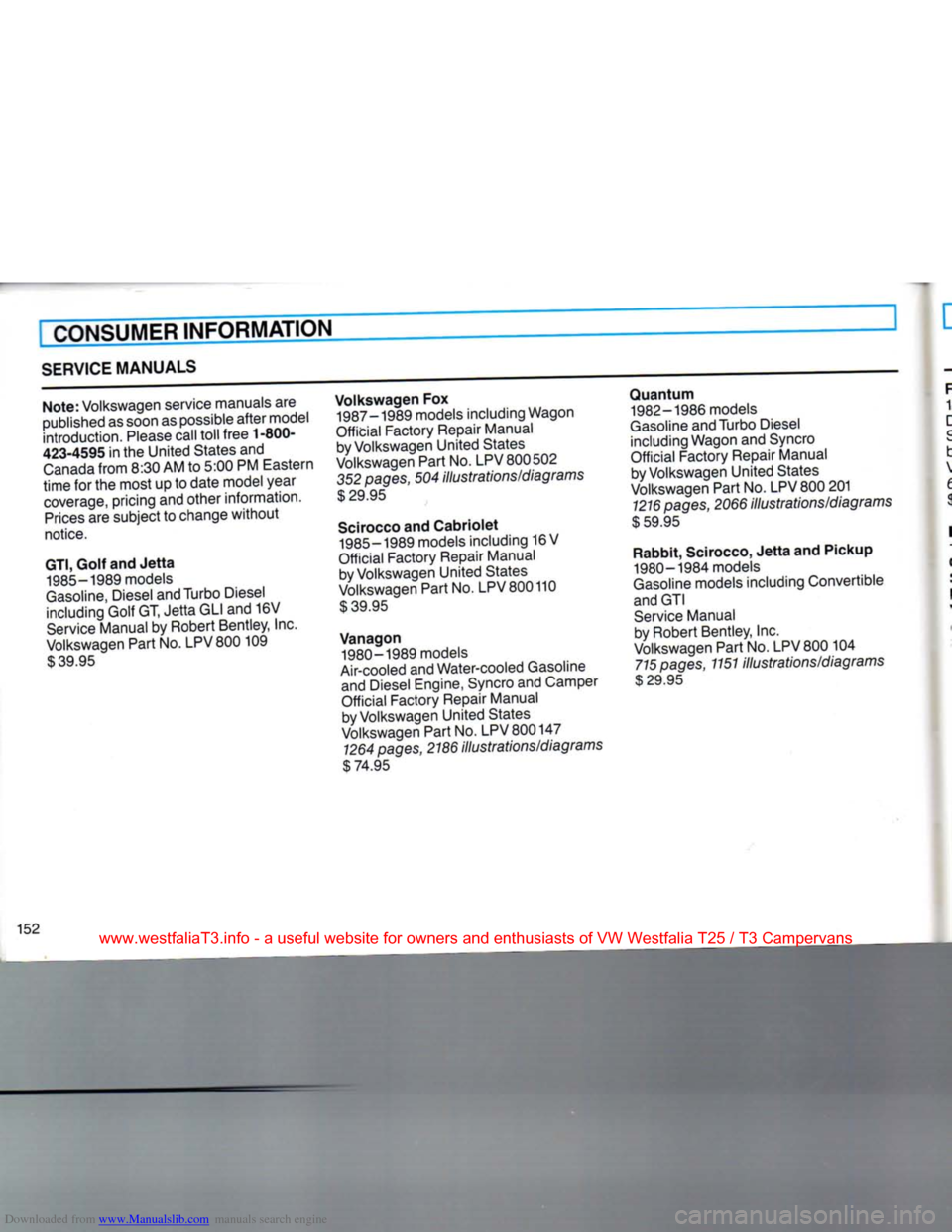
Downloaded from www.Manualslib.com manuals search engine
CONSUMER
INFORMATION
SERVICE MANUALS
Note:
Volkswagen service manuals are
published as soon as possible
after
model
introduction.
Please
call
toll
free 1-800-
423-4595
in the United States and
Canada
from
8:30 AM to 5:00 PM Eastern
time
for the most up to date model year
coverage,
pricing and other information.
Prices
are subject to change
without
notice.
GTI,
Golf
and
Jetta
1985-1989 models
Gasoline,
Diesel and Turbo Diesel
including Golf GT, Jetta GLI and 16V
Service
Manual by Robert Bentley, Inc.
Volkswagen Part No. LPV 800 109 $39.95
Volkswagen
Fox
1987-1989 models including Wagon
Official Factory Repair Manual by Volkswagen United States
Volkswagen Part No. LPV800502 352 pages, 504 illustrations/diagrams
$29.95
Scirocco and
Cabriolet
1985-1989 models including 16 V
Official Factory Repair Manual
by Volkswagen United States
Volkswagen Part No. LPV 800110 $39.95
Vanagon
1980-1989 models
Air-cooled and Water-cooled Gasoline and Diesel Engine, Syncro and Camper
Official Factory Repair Manual by Volkswagen United States
Volkswagen Part No. LPV 800147 1264 pages, 2186 illustrations/diagrams
$
74.95
Quantum
1982-1986 models
Gasoline
and Turbo Diesel
including Wagon and Syncro
Official Factory Repair Manual
by Volkswagen United States
Volkswagen Part No. LPV 800 201 7276 pages,
2066
illustrations/diagrams
$59.95
Rabbit,
Scirocco,
Jetta
and
Pickup
1980-1984 models
Gasoline
models including Convertible
and GTI
Service
Manual
by Robert Bentley, Inc.
Volkswagen Part No. LPV 800 104 775 pages, 1151 illustrations/diagrams
$29.95
www.westfaliaT3.info - a useful website for owners and enthusiasts of VW Westfalia T25 / T3 Campervans